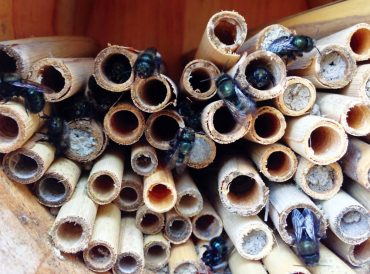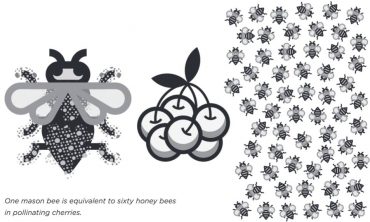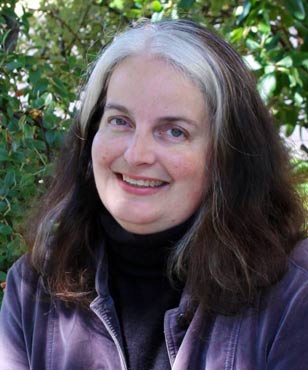
to warm them before starting their busy day.
(Photo courtesy Dave Hunter/Crown Bees)
Editor’s note: This is an excerpt from “Mason Bee Revolution: How the Hardest Working Bee Can Save the World One Backyard at a Time,” a book by Dave Hunter and Jill LIghtner recently released by Seattle-based Mountaineers Books. Read Part 1 to learn about the types of gentle bees and how mason bees are different.
Pollen’s Place in the Garden
Most of us are not serious orchardists — perhaps you have a fruit tree or some berry bushes, or have been thinking about adding one or the other to your garden. Depending on what you have, you might even think your pollination needs are already met, because many fruit trees and berry bushes sold today are labeled “self-pollinating.”
This leads to the assumption that they do not actually need the presence of pollinating insects to help them along. This is an unfortunate error in communication, as only about 10 percent of plants are wind pollinated, without any kind of assistance from insects or, less commonly, birds.
What self-pollinating refers to is this: Originally, many kinds of berries and fruiting trees required two plants — one male and one female — to convert their flowers into any fruit at all. You relied on the wind or native wild pollinators to transfer pollen back and forth between the flowers, and only the female plants would ultimately bear fruit.
Self-pollinating means you do not need to worry about male and female plants, but you do still need to make sure that pollen moves around between the blossoms on your tree or shrub. That is why encouraging effective pollinators in your garden can make such a big difference.
While mason bees drop a lot of pollen, they are so dedicated to crawling across flowers that the pollen dropping off their furry bellies lands right where you want it: on another flower.
When the wind drops pollen, it is just as likely to blow down the street or onto a sidewalk as it is to land on another part of your fruit tree. More pollen in the right place equals more reason for flowers to become fruit. Mason bees have been shown repeatedly to be masters at getting pollen right where it is most wanted: on other blossoms.
If you ever have the opportunity to see a mason bee and a honey bee work side by side, you will spot an obvious behavioral difference. Honey bees are extraordinarily methodical creatures: They begin work on one limb of a tree, collect pollen only from the blossoms on that limb until they are full up, then return to the hive.
On their second trip to the tree, they will pick up close to where they left off. They are so thorough that the process is sometimes referred to as “stripping the pollen.”
In comparison, mason bees are more like distracted little grazers, flitting from one blossom on one tree to another blossom on a totally different tree. While you can imagine a honey bee frowning and tsk-tsking at this distracted behavior, mason bees are dropping pollen everywhere with this scattershot method, and it is absolutely terrific for cross-pollination.
More Bees Equals More Food
Interesting stuff, but chances are you are not a cherry or almond farmer. And you probably see a smattering of honey and bumblebees in your yard each summer as it is. Perhaps you already have stopped using chemical treatments on the lawn and buy organic produce when you shop — why do more? There are a few compelling reasons, each with an altruistic side as well as a component of pure self-interest.
This is big-picture, long-term thinking. Because of numerous honey-bee challenges, every state has already lost massive numbers of a key pollinator. Thanks to commercial spraying to control pests on farms, in suburban parks and along urban streets in some regions, wild bees like bumblebees, as well as mining bees and wasps, are also having trouble.
Mason bee populations are hanging in there on their own for now, but without some careful attention and a simple seasonal care routine, their population will not grow enough to compensate for the losses in other areas. And of course they can also be affected by regional use of pesticides; they are most troubled by slightly different ones than honey bees.
You can easily help increase the mason bee population by adding a bee house to your own garden, or buying one for a community school or garden, and then showing a teacher or garden educator how to take care of it.
Increasing the bees’ numbers directly assists in increasing yields of nearby fruit trees, whether those trees belong to you or the garden where you put the bee house. More fruit equals more healthy food for school kids to snack on, or for you to turn into delicious homemade treats.
By raising mason bees yourself, you can witness and assist in developing an increase in their total population, expanding the good that pollinators do for fruit and nut crop yields, one backyard at a time. In this case, introducing mason bees helps take some of the immediate stress off honey bees, and boosts the fresh food supply at a modest level for your community. Depending on where you live, you might see more cherries or apples, bumper crops of plums or apricots, or more abundant pears, peaches, or nuts.
Putting Bees First Means Fewer Chemicals
This is community-based thinking. A wide range of pesticides are being continually investigated for their effects, not just on honey bee health but on human health. At the same time, a number of herbicides appear to be leading to the fast evolution of ever-more-determined invasive weeds.
At one time in the not-so-distant past, these modern agricultural chemicals were seen as an elegant, educated solution to myriad plant problems that farmers were having serious issues with: The 1970s saw massive crop failures on many continents. The United States was able to quickly ramp up food production in part because of these chemicals, along with new high-yielding plant varietals that in many cases were also developed to withstand increased use of pesticides.
Techniques like monoculture became the standard in large-scale agriculture in this era, because growing massive fields of a single crop makes it easy and efficient to plant, grow, and harvest with minimal workers. Any weeds could be eliminated through sprays that made farming much easier.
But we are now seeing many downsides to the agricultural practices of the 1970s and ’80s, and smaller-scale organic and biodynamic and permaculture farming techniques are being eyed as the right direction for many reasons.
Washington State University was the first university in the nation to offer an undergraduate degree in organic agriculture, back in 2008; countless more from Florida to Michigan now offer it as an area of concentration or a postgraduate degree, or have developed an undergraduate program in the looser arena of sustainable agriculture. What was once a topic reserved for hippies has become a matter of course for future farmers around the world.
This shift in thinking is also seen in local governments, as a few have moved to ban the spraying of trees when they are in bloom, or have acted to prevent the use of certain chemicals on government-owned land. And consumers are playing a role — after major hardware chains came under fire for selling nursery plants that had been treated with potentially pollinator-harming chemicals, Lowe’s was the first to announce in 2015 a plan to phase out nursery plants treated with neonicotinoids, within 48 months.
Previous to that announcement, Home Depot declared that it would require labeling of any nursery plants treated with neonicotinoids, a program that began in the summer of 2015. Of course, these labels are effective in reducing the use of the chemicals only if consumers use the newly available information to change their buying habits and seek out untreated plants.
Organophosphates are another broad category of chemicals coming under fire in the United States and abroad. These efforts are scattershot, having bigger impacts in some communities than others, but nonetheless, change is in the air.
You can be part of that change by introducing mason bees and leafcutters to your own garden and treating them as a highly valuable addition, just as you would treat an expensive new plant. Gardening with bees in mind means reducing your own use of chemicals, and either finding natural treatments for plant diseases or learning to live with less-than-perfect looks. A thriving ecosystem is within the reach of every gardener, whether you have only a tiny townhouse plot, a large suburban lot, or several acres all to yourself.
Dave Hunter and Jill Lightner are the authors of the newly released book "Mason Bee Revolution: How the Hardest Working Bee Can Save the World One Backyard at a Time," published by Seattle's Mountaineers Books. While you can't harvest honey from mason bees, you can create a robust urban garden, encourage healthy crops in your city and help safeguard our food supply. The book explores the facts (and fictions) of pollination and food production, with a focus on how mason bees can help everyday gardeners get more from their own fruit trees, berry patches and vegetable beds. For more information, go to www.mountaineersbooks.org.






























